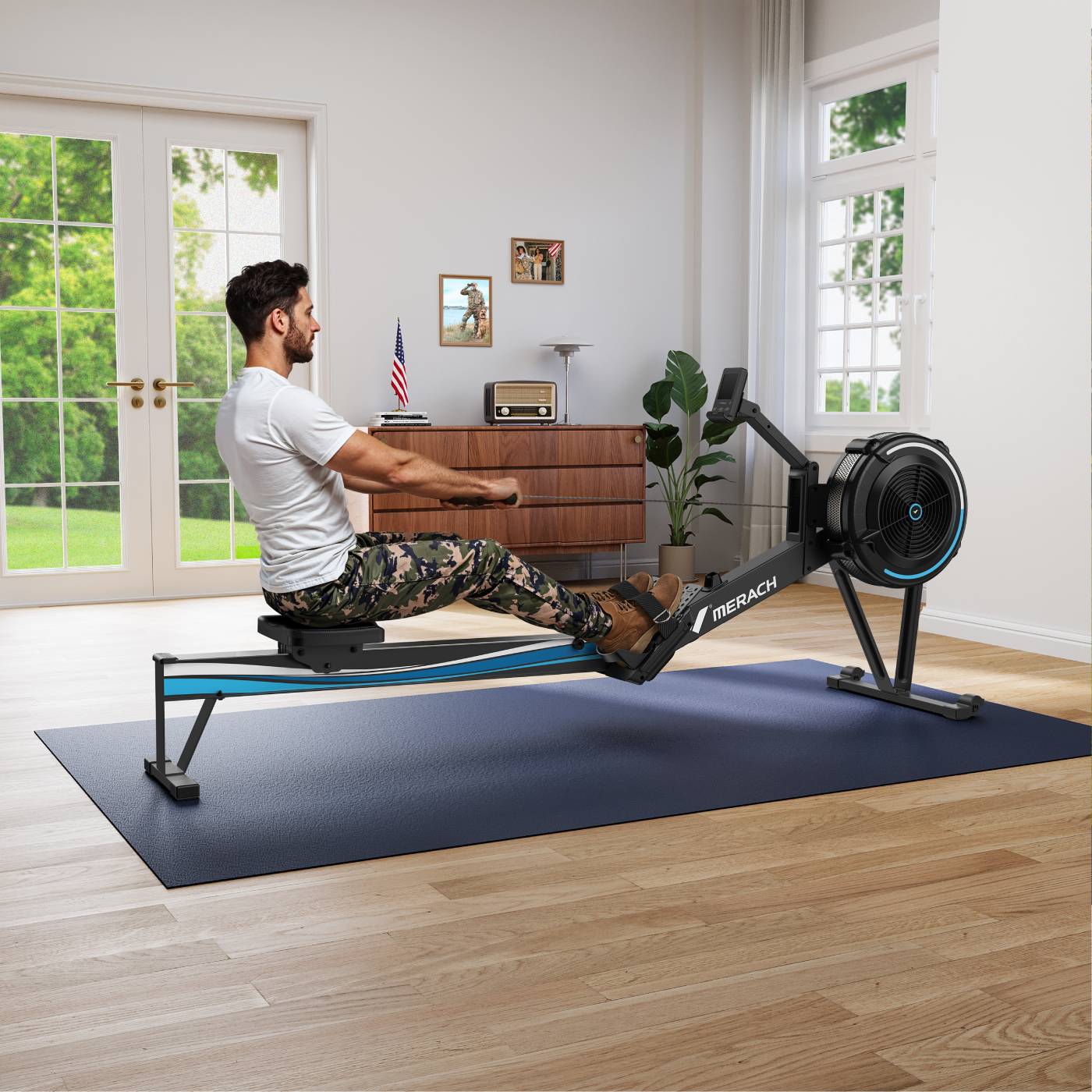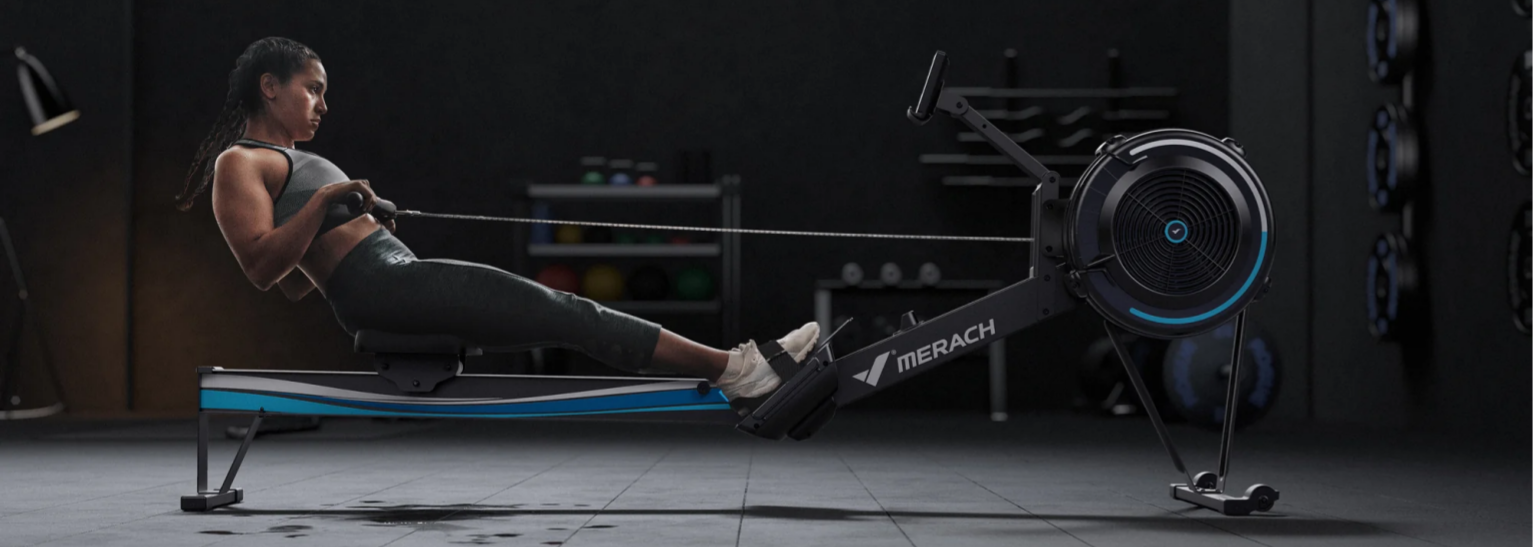If you know the benefits of the rowing machine and have read all the rowing machine buyer's guides, then you might have this question: Should I choose a water rower or a magnetic rower?
Although there are different types of rowing machines, most would hesitate about these two.
But don't worry, we'll break down the key differences between these two popular resistance mechanisms to help you find out which one best suits your specific needs, preferences, and circumstances.
Quick Comparison: Water vs Magnetic Rowing Machines
| Feature | Water Rowing Machines | Magnetic Rowing Machines |
|---|---|---|
| Resistance Feel | Natural, fluid resistance that increases with effort | Consistent, mechanical resistance regardless of effort |
| Noise Level | Moderate (60-75 dB) with pleasant water sounds | Very quiet (50-65 dB) with minimal mechanical noise |
| Resistance Adjustment | Natural adjustment through effort; manual by changing water level | Digital or manual controls with precise resistance levels |
| Maintenance | Requires occasional water treatment and monitoring | Minimal maintenance with fewer moving parts |
| Price Range | 2,300+ | 2,000+ |
| Aesthetics | Often more visually appealing, especially wooden models | Typically more utilitarian, fitness-equipment appearance |
| Weight | Heavier, especially when filled with water (70-110+ lbs) | Generally lighter and more portable (55-85 lbs) |
| Storage | Some models stand upright; non-folding designs | Many models fold for compact storage |
| Performance Metrics | Good but may have slight variations between machines | More precise and consistent across same models |
| Sound Profile | Rhythmic water sounds | Near-silent operation |
| Best For | Authentic rowing experience, aesthetics, natural feel | Quiet operation, precise training, tech integration |
Now, let's examine the key differences in detail to help you better understand these two.
Water Resistance: Natural Fluid Dynamics
Water rowing machines generate resistance through paddles spinning in an enclosed tank of water. Each stroke pulls these paddles through water, creating resistance that naturally increases with effort—the harder you pull, the greater the resistance you feel. This quadratic resistance pattern closely mimics the physics of on-water rowing, where resistance increases exponentially with force application.

Magnetic Resistance: Precisely Controlled Force
Magnetic rowing machines use the interaction between magnets and a metal flywheel to create resistance. As moving parts pass through the magnetic field, eddy currents develop that resist motion. Unlike water resistance, magnetic systems provide consistent resistance regardless of how hard you pull, with changes made only by manually or electronically adjusting the magnetic force applied to the flywheel.

8 Key Differences Between Water and Magnetic Rowing Machines
1. Rowing Feel and Experience
Water rowing machines deliver a smooth, fluid stroke that authentically recreates the on-water rowing experience. The resistance naturally builds throughout the stroke with a slight catch at the beginning, followed by a powerful drive phase and gentle release at the finish. Many users describe the experience as more organic and satisfying, with a natural rhythm that helps maintain proper form.
Magnetic rowing machines provide a more consistent, uniform resistance throughout the entire stroke. The resistance feels the same from the moment you begin pulling until you complete the stroke, creating a more predictable and controlled experience. This consistency can be beneficial for structured training but lacks the variable, natural feel that many rowing enthusiasts prefer.
2. Noise Level
Just like rowing in the water, water rowers produce a distinctive, rhythmic swishing sound as the paddles move through water, typically measuring between 60-75 decibels during use. Many users find this sound meditative and enjoyable—comparable to the peaceful sounds of rowing on actual water. However, this noise may be noticeable to others in shared living spaces, particularly during early morning or late evening workouts.
On the other hand, magnetic rowers operate much more quietly, generating only minimal mechanical sounds measuring between 50-65 decibels. This near-silent operation makes magnetic rowers ideal for apartment dwellers, those with sleeping children, or anyone who prefers to watch television or listen to music at low volumes while exercising. The quiet nature of magnetic systems is often a deciding factor for those concerned about disturbing others.
3. Resistance and Control
Water rowing machines adjust resistance primarily through your effort level—rowing harder automatically creates more resistance without changing any settings. Some adjustment is possible by adding or removing water from the tank, but this requires stopping your workout and isn't practical for mid-session changes.
Magnetic rowing machines feature specific resistance levels (typically 8-32 levels) that can be adjusted instantly via digital console or manual dial. This precise control allows for structured interval training with exact resistance changes at specific times. The ability to precisely define and repeat resistance levels makes magnetic systems particularly valuable for programmed workouts and multi-user households.
4. Maintenance Requirements
Water rowing machines require periodic maintenance to keep the water clean and prevent algae growth. This typically involves adding purification tablets every 6-12 months and occasionally topping off water levels due to evaporation. Additionally, if you need to move the machine, you'll likely need to empty the water tank first, adding an extra step to relocation.
Magnetic rowing machines require minimal maintenance beyond keeping the rail clean and occasionally checking moving parts. With fewer components that require attention and no water to monitor or treat, magnetic systems represent the lower-maintenance option. This "set-it-and-forget-it" quality makes magnetic rowers particularly appealing to those who prefer hassle-free equipment.
5. Price and Value
Water rowing machines typically start at higher price points, with entry-level models beginning around 2,300+. The higher starting price reflects the more complex water resistance mechanism and often superior build materials like wood. However, here at Merach, we've made quality water rowing machines without breaking your bank. Check out our water rowing machines.
Magnetic rowing machines offer more accessible entry points, with budget models starting around 2,000+. The wider price range makes magnetic systems more accessible to beginners or those with limited budgets. Mid-range magnetic rowers (1,200) often represent an excellent value proposition with solid durability and features.
6. Aesthetics and Design
Water rowing machines, particularly those with wooden frames like the classic WaterRower, offer superior aesthetics that complement home décor. Their organic materials and craftsman-like appearance allow them to blend seamlessly in living spaces rather than looking like typical exercise equipment. Many owners keep these machines permanently visible because they enhance rather than detract from room aesthetics.
Magnetic rowing machines typically feature more utilitarian designs with metal frames, plastic components, and a technical appearance that clearly reads as exercise equipment. While some higher-end models incorporate sleeker designs, most magnetic rowers prioritize function over form. For dedicated exercise spaces this matters less, but in multi-purpose rooms the more industrial appearance may be a consideration.
7. Performance
Water rowing machines typically measure paddle speed and mathematically convert this to performance metrics. While generally accurate, this indirect measurement can result in slight variations between identical machines and potential calibration drift over time. Advanced water rowers have significantly improved in this area, but some inconsistency remains inherent to the system.
Magnetic rowing machines offer more precise, consistent performance measurements by directly measuring force against known resistance levels. This consistency makes magnetic systems preferred for those tracking specific performance metrics or training for competition. The standardized measurement is particularly important for comparing results across different workout sessions or between rowers.
8. Storage and Space
Water rowing machines tend to be heavier (especially when filled with water) and many premium models don't fold for storage. While some can be stored upright to reduce footprint, they generally require more permanent space allocation. The water tank also means more careful handling is required when moving the machine.
Magnetic rowing machines are typically lighter and many models feature folding designs that significantly reduce their footprint when not in use. This space efficiency makes magnetic rowers more practical for homes with limited space or multi-purpose rooms. The easier mobility also allows for more flexible placement options throughout your home.
Who Should Choose a Water Rowing Machine?
Water rowing machines are ideal for:
- Technique-focused rowers who value authentic feel and natural resistance patterns
- Design-conscious users who want equipment that complements home décor
- Sensory-oriented exercisers who enjoy the meditative sound of water
- On-water rowers looking for training equipment with transferable feel
- Long-term investors willing to pay more upfront for aesthetic and experiential benefits
Who Should Choose a Magnetic Rowing Machine?
Magnetic rowing machines are better suited for:
- Data-driven trainers who need consistent, measurable resistance levels
- Apartment dwellers requiring minimal noise operation
- Multiple-user households where different resistance levels are frequently needed
- Space-conscious users who benefit from folding storage capabilities
- Low-maintenance seekers who prefer minimal upkeep requirements
- Budget-conscious buyers looking for quality options at lower price points
Making Your Decision: Quiz to Find out Your Ideal Rowing Machine
To determine which type is best for your specific situation, answer these key questions:
-
Is noise a significant concern in your living situation?
- If yes, magnetic rowing machine
- If no, either option works
-
Will your rower be visible in a main living area?
- If yes and aesthetics matter, water rowing machine
- If no or aesthetics don't matter, either option works
-
Do you need to save space when the rower isn't in use?
- If yes, magnetic rowing machine (folding models)
- If no, either option works
-
Is precise, adjustable resistance important for your training?
- If yes, magnetic rowing machine
- If no, either option works
-
Do you strongly prefer the authentic feel of rowing on water?
- If yes, water rowing machine
- If no, either option works
-
Is maintenance simplicity a high priority?
- If yes, magnetic rowing machine
- If no, either option works
-
Is your budget limited to under $700?
- If yes, magnetic rowing machine
- If no, either option works
If you answered "magnetic rowing machine" to more questions, that's likely your better choice. If water rowing machine appeared more frequently, that system probably suit better with your priorities.
Top Recommendations in Each Category
Based on our extensive testing, here are standout models in each resistance category:
Best Water Rowing Machines
- Best Overall Water Rower: R28 WaterRower Natural Rowing Machine ($307)
- Premium Experience: 950 Dual Resistance Wood Rower ($699)
-
Budget-Friendly Water Option: R28 WaterRower Natural Rowing Machine ($307)
Best Magnetic Rowing Machines
- Best Overall Magnetic Rower: Q1S Self-Powered Auto Magnetic Rower
- Premium Tech Integration: Q1S Auto Electromagnetic Smart Rower
- Budget-Friendly Option: R15 Magnetic Rowing Machine
Conclusion
Both water and magnetic rowing machines offer exceptional workout experiences, each with distinct advantages that appeal to different user priorities. Water rowing machines excel in providing an authentic, engaging sensory experience with beautiful design elements that many users find more motivating for long-term use. Magnetic rowing machines offer precise control, minimal maintenance, quieter operation, and often more affordable entry points.
Whichever you choose, remember that consistency determines results more than equipment selection. The best rowing machine is always the one you'll use regularly with enthusiasm and purpose.































Leave a comment
This site is protected by hCaptcha and the hCaptcha Privacy Policy and Terms of Service apply.